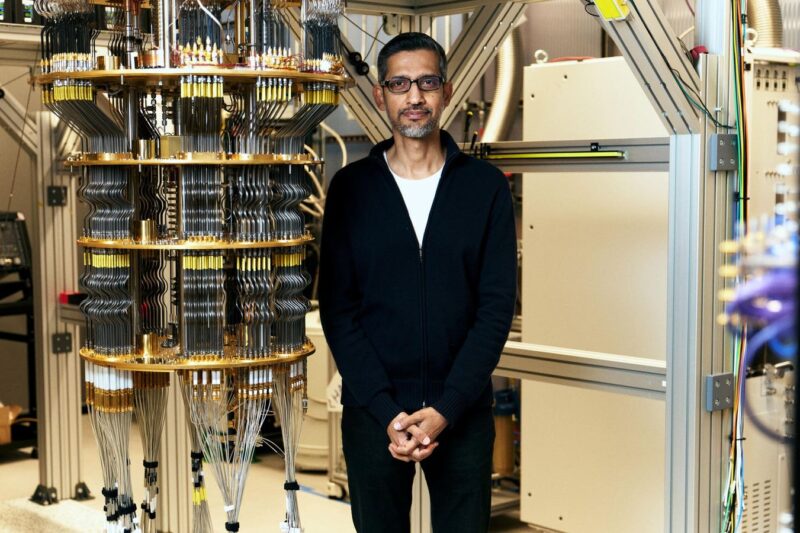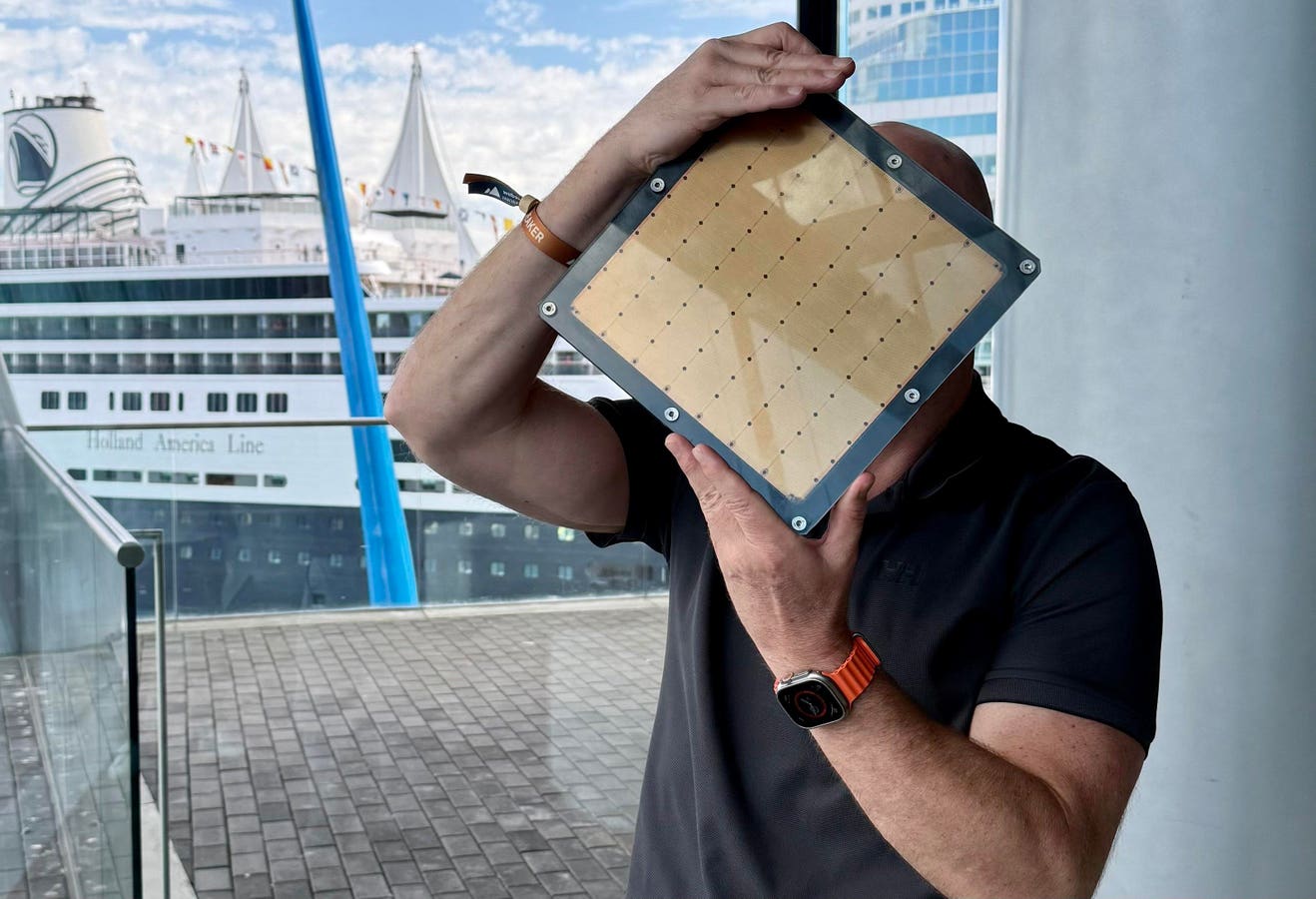In this week’s edition of The Prototype, we look at two big quantum computing milestones, the man trying to build the next Tesla, a retinal implant that restores eyesight and more. To get The Prototype in your inbox, sign up here.
Google CEO Sundar Pichai with the company’s quantum computer
Earlier this week, Google hit a significant quantum computing milestone, using its Willow chip to make calculations an estimated 13,000 times faster than a conventional computer chip. The tech giant published its findings in Nature.
This isn’t the first time Google—or other quantum computing companies—have claimed this type of “quantum supremacy,” but two things stand out about these results. First, these calculations are directly applicable to practical problems; the company is already applying them to predicting chemical structures, which is useful for drug discovery or materials science.
Second, this is the first time such a claim is potentially verifiable, according to Scott Aaronson, a computer science professor at UT Austin—any quantum computer should be able to follow the method and get the same results. “I’ve regarded efficiently verifiable quantum supremacy as one of the biggest challenges of the field for the past several years, so I’m thrilled that Google and others are making clear progress directly on that,” he told me.
One major quantum computing challenge is the fragility of connections between quantum bits—or “qubits”—making them prone to error. A lot of work in the field is geared both towards efficiently correcting errors during processing and preventing them from happening in the first place. In the meantime, this fragility limits the complexity of problems that can be solved on quantum machines.
Quantum computing company IonQ made a big step in that direction this week when it announced it had achieved 99.99% gate fidelity between two qubits. In other words, a .01% error rate. That’s a first for a quantum computation and helps the company pave the way for computers that can tackle harder problems.
Aaronson told me this could be crucial for the company as it scales up to bigger quantum processors. “In the past, gate fidelity has usually gone down when you try to integrate larger numbers of qubits into bigger systems,” he said. Higher gate fidelity at smaller levels, he added, gives engineers more “wiggle room” to build the chips needed to tackle practical problems.
RJ Scaringe Is Betting His New Electric SUV Will Make Rivian The Next Tesla
Rivian’s R2 electric SUV
Eric Anderson for Rivian
Rivian has had a rocky time since it began selling electric vehicles in 2021. It missed initial volume goals, leading to back-to-back years of weak sales. Then there have been post-Covid-19 parts shortages, inflation, as well as steel and aluminum tariffs. And now, it’s facing a federal administration that’s no fan of EVs. But CEO RJ Scaringe says he’s more optimistic than ever ahead of the company’s next major product launch: the R2 small electric SUV that will go head-to-head with Tesla’s top-selling Model Y.
“I’m very, very biased, but I think R2 is going to drive a step-change in overall EV adoption,” he told Forbes. “Not too different from what happened with Tesla.”
Rivian is starting up production of the R2, which will be tens of thousands of dollars cheaper and smaller than Rivian’s current R1S SUV and R1T pickup, with U.S. sales to begin in early 2026. It’s priced from $45,000, which is below the current average selling price for all new U.S. vehicles. Rivian will have the capacity to build more than 160,000 R2s annually at its Normal, Illinois factory that currently makes its R1 models and EDV commercial vans that Amazon and other companies use. Aside from being priced in line with the top-selling U.S. small crossover category, Scaringe says the R2 will stand out for both its tech inside the cabin, 300-mile range and ability to actually handle off-road driving.
After the challenges of the last few years, it needs to be as good as he claims and a hit with consumers. It’s Rivian’s “make or break vehicle,” said Ed Kim, president and chief analyst for industry researcher AutoPacific.
Read more at Forbes.
DISCOVERY OF THE WEEK: A SIGHT RESTORING IMPLANT
A retinal implant developed by brain-computer interface startup Science restored vision to 80% of advanced macular degeneration patients in a clinical trial, according to a study in the New England Journal of Medicine. The device bypasses rods and cones damaged by the disease, directly stimulating the cells beneath to restore sight. The company has applied for regulatory approval of its implant in Europe.
WHAT ELSE I WROTE THIS WEEK
In my other newsletter, InnovationRx, Amy Feldman and I looked at the latest cancer treatment breakthroughs from a recent conference, a high-tech chair that could revolutionize cancer radiation therapy, AI chatbots for seniors, a startup applying ride-share mapping to healthcare navigation, and more.
SCIENCE AND TECH TIDBITS
NASA will be reopening solicitations for a contract that had been awarded to SpaceX to return astronauts to the moon, with acting Administrator Sean Duffy saying the Elon Musk-led company is “behind schedule.”
Shares of quantum computing companies surged Thursday after a Wall Street Journal report said they were in talks to give equity stakes to the federal government in exchange for funding, mirroring earlier deals reached with Intel and several rare earth mining companies.
Cancer patients treated with immunotherapy who got an mRNA Covid-19 vaccine were twice as likely to survive after three years compared to those who did not.
Lithium-ion battery recycling company Redwood Materials just raised $350 million to expand its ability to supply grid-scale energy storage systems as AI data centers accelerate electricity demand.
Researchers at the U.K. Atomic Energy Authority were able to stabilize plasma with a 3D magnetic field for the first time, a key step for the sustainable fusion reactions needed for power generation.
PRO SCIENCE TIP: COUNTERACT JUNK FOOD BLUES A RUN
High-fat, high-sugar foods are known to trigger depressive feelings and anxiety, but new findings suggest you can mitigate those effects by going for a run. These results came from a 7-week study of rats divided into two groups—one on a healthy diet and one on a more typical junk food diet. The rats on a healthier diet saw more overall benefits from exercise, but it did act to ease behaviors associated with anxiety and depression in the junk food group.
WHAT’S ENTERTAINING ME THIS WEEK
A couple of months ago I sang the praises of Rob Hart’s Assassin’s Anonymous. Now I’m back to praise its sequel, The Medusa Protocol. Like the first one, this is the story of another recovering killer whose past has caught up with her. But with the premise of 12-step-following, ex-assassins dispensed with, Hart crafts an entertaining book that’s also a deconstruction of typical thrillers—really exploring how damaging violence is to both victim and perpetrator. A popcorn book on the surface, it offers more food for thought underneath. I’m looking forward to the next title in the series: Three Hitmen and a Baby.
MORE FROM FORBES








